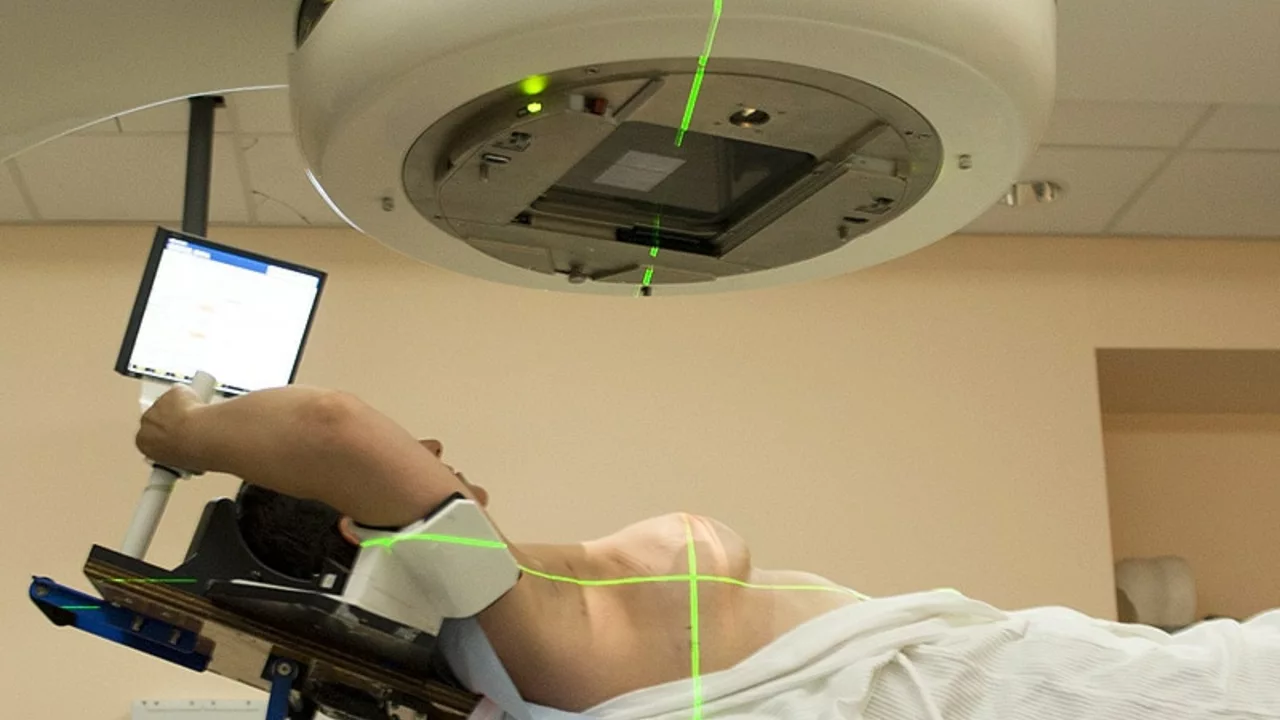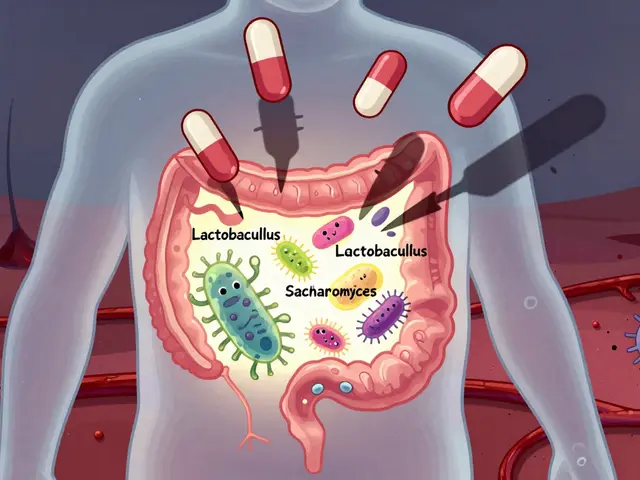
Understanding Kaposi Sarcoma
Before we dive into the specifics of radiation therapy for Kaposi Sarcoma, it's important to first understand what this disease is. Kaposi Sarcoma is a rare type of cancer that typically appears as tumors on the skin. However, it can also affect other parts of the body such as the lungs, lymph nodes, and digestive tract. It's most commonly associated with individuals who have weakened immune systems, like those with HIV/AIDS or who have undergone organ transplantation.
This condition is named after Moritz Kaposi, a dermatologist who first described it in the late 19th century. Today, despite advances in medicine, Kaposi Sarcoma remains a serious health issue, especially in sub-Saharan Africa where it's one of the most common cancers in men.
What is Radiation Therapy?
Radiation therapy is a common form of cancer treatment that uses high-energy waves or particles to kill or damage cancer cells. It works by damaging the DNA of these cells, making it hard for them to grow and multiply. Over time, the damaged cells die and are naturally eliminated from the body.
There are two main types of radiation therapy: external beam radiation therapy and internal radiation therapy. In the case of Kaposi Sarcoma, external beam radiation is typically used. It involves a machine that directs the high-energy rays to the exact location of the cancer.
The Procedure of Radiation Therapy for Kaposi Sarcoma
The process of receiving radiation therapy for Kaposi Sarcoma is quite straightforward. Before the actual treatment, a planning session is conducted where the radiation oncologist determines the precise area to be treated. This often involves a CT scan or MRI. The patient then lies on a table while the machine moves around them, directing the radiation to the specified area.
The sessions are typically short, usually lasting about 15 to 30 minutes, and are generally painless. The number of sessions needed can vary depending on the size and location of the tumor, as well as the patient's overall health.
Effectiveness of Radiation Therapy for Kaposi Sarcoma
Radiation therapy has been shown to be an effective treatment for Kaposi Sarcoma, especially when the disease is localized. It can help reduce the size of the tumors and alleviate symptoms such as pain and swelling. In many cases, the tumors can disappear completely after treatment. However, it's important to note that radiation therapy is not a cure for Kaposi Sarcoma. It is primarily used to control the disease and improve the quality of life for patients.
Potential Side Effects
While radiation therapy is effective, it does come with potential side effects. These can include skin changes in the treated area, such as redness, dryness, or peeling. Other common side effects include fatigue, nausea, and loss of appetite. However, these side effects are usually temporary and can be managed with medications and other supportive care.
Benefits of Radiation Therapy
Despite the potential side effects, there are several benefits to using radiation therapy for Kaposi Sarcoma. For one, it's a non-invasive treatment that doesn't require surgery. This can be a suitable option for patients who are not good candidates for surgery due to other health conditions. Furthermore, radiation therapy can be tailored to the specific needs of each patient, allowing for a more personalized approach to treatment.
Combining Radiation Therapy with Other Treatments
In some cases, radiation therapy can be used in combination with other treatments for Kaposi Sarcoma, such as chemotherapy or immunotherapy. This approach, known as multimodal therapy, can be more effective than using a single treatment alone. However, the decision to use multimodal therapy should be made carefully, taking into consideration the patient's overall health and the potential side effects of the combined treatments.
Living with Kaposi Sarcoma
Living with Kaposi Sarcoma can be challenging, especially given its association with other conditions like HIV/AIDS. It's important for patients to receive comprehensive care that not only addresses the cancer, but also their overall well-being. This includes emotional support and symptom management. Fortunately, with the right treatment approach, many people with Kaposi Sarcoma can lead fulfilling lives.
Conclusion: Hope through Radiation Therapy
In conclusion, radiation therapy is a viable and effective treatment option for Kaposi Sarcoma. While it is not a cure, it can significantly improve a patient's quality of life by reducing symptoms and slowing the progression of the disease. As with any treatment, it is important to discuss the potential risks and benefits with your healthcare provider.






9 Comments
Radiation therapy, when meticulously planned, offers a potent weapon against localized Kaposi sarcoma lesions. By delivering precisely calibrated doses, it can shrink tumors while preserving surrounding healthy tissue. The non‑invasive nature of external beam radiation makes it especially suitable for patients who are not surgical candidates. Moreover, its rapid treatment schedule-often completed within a few weeks-can significantly improve quality of life. Clinicians should, however, tailor the regimen to each patient’s immunological status and co‑morbidities to maximize benefit.
/p>Absolutely, the balance between efficacy and side‑effects is key, and a supportive care team can help manage fatigue and skin changes. Encouraging patients to maintain nutrition and gentle activity can further boost outcomes. Remember, open communication with the radiation oncologist ensures the plan stays aligned with the patient’s evolving health.
/p>Honestly, the hype around radiation for Kaposi sarcoma feels overblown-there are cheaper alternatives that get the job done.
/p>i guess ppl just love to glorify fancy tech even when simple chemo is enough. it's like they think radiation is some magic wand. u c, why bother?
/p>Look, I’ve read a ton of stuff on this and let me tell ya, the data’s pretty solid-if you ignore the occasional typo in the papers, radiation slashes those lesions like a hot knife through butter. The thing is, you gotta make sure the dosage is spot‑on; otherwise you’re just burning skin for no gain. And yeah, some folks claim the side‑effects are scary, but most of the time it’s just temporary redness and a bit of fatigue. So, don’t let the naysayers scare you away from a treatment that actually works.
/p>Wow, radiation-what a novel concept.
/p>It's interesting to note how Kaposi sarcoma prevalence varies across regions, especially in sub‑Saharan Africa where cultural perceptions of illness can influence treatment uptake. Understanding local health beliefs helps clinicians present radiation therapy in a way that resonates with patients. Tailoring communication to respect traditions while explaining the benefits can improve adherence. Ultimately, cultural sensitivity is as vital as the medical regimen itself.
/p>Radiation therapy for Kaposi sarcoma is truly a marvel of modern medicine, and I cannot stress enough how it revolutionizes patient care 🌟. First, the precision of external beam technology allows oncologists to target lesions down to the millimeter, sparing healthy tissue and preserving function. Second, the treatment schedule is remarkably concise-usually a handful of sessions that fit neatly into a busy life 📅. Third, the side‑effects, while present, are generally mild and manageable with simple topical ointments and hydration. Fourth, evidence shows that tumor regression rates exceed eighty percent in many studies, a statistic that simply cannot be ignored. Fifth, for those living with HIV, radiation does not exacerbate immunosuppression, making it a safe adjunct to antiretroviral therapy. Sixth, the psychological boost from seeing visible tumor shrinkage cannot be understated; confidence surges, and quality of life improves dramatically. Seventh, the cost‑effectiveness of a few radiation visits often outweighs prolonged chemotherapy regimens, especially in resource‑limited settings. Eighth, integrating radiation with immunotherapy can produce synergistic effects, unleashing the body's own defenses against residual disease. Ninth, technological advances like intensity‑modulated radiation therapy (IMRT) further refine dose distribution, reducing collateral damage. Tenth, patients report that the procedure itself is painless-just a short lie‑down while the machine hums softly. Eleventh, the rapid relief from painful lesions means patients can return to daily activities sooner rather than later. Twelfth, the non‑invasive nature eliminates surgical risks, crucial for patients with comorbidities. Thirteenth, the availability of outpatient radiation centers expands access, allowing treatment without hospital admission. Fourteenth, ongoing research continues to fine‑tune fractionation schedules, promising even better outcomes. Fifteenth, the communal support networks often rally around those undergoing radiation, providing emotional scaffolding. Finally, if you ask any seasoned oncologist, they’ll tell you that radiation remains a cornerstone in the multidisciplinary arsenal against Kaposi sarcoma 😎.
/p>Sure, because the shadowy pharma lobby definitely wants us all to get radiation 🙄.
/p>